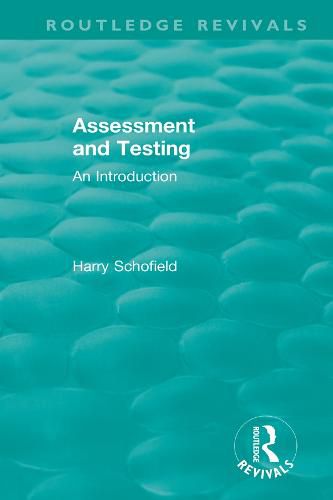Readings Newsletter
Become a Readings Member to make your shopping experience even easier.
Sign in or sign up for free!
You’re not far away from qualifying for FREE standard shipping within Australia
You’ve qualified for FREE standard shipping within Australia
The cart is loading…






Originally published in 1972, there were many ‘classics’ dealing with assessment and testing on the market at the time, but most of these left the inexperienced reader bewildered in the early stages, because of their size and insufficient explanation of the many technical terms used. There were a distinct lack of books which gave students in Colleges of Education dealing with psychology for the first time a simple explanation of basic terms in assessment and testing, and which introduced them briefly to the different types of tests available.
Assessment and Testing aimed to fill this large gap. It looks at such key psychological terms as ‘sample’, ‘objectivity’, ‘subjectivity’, and such basic statistical terms such as ‘mean’, ‘standard deviation’, and ‘normal curve of distribution’. Because it assumes that the reader has no knowledge of such terms, it gives careful and simply illustrated explanations of each.
In the same way, in simple language, with any technical terms explained and illustrated, it explains intelligence and personality tests, questionnaires, sociometric measures, projection techniques, and other areas of assessment and testing which every practising teacher will meet.
The book aims to be essentially practical. It is appreciated all the time that the readers are those who will teach children. It is designed to provide a solid foundation upon which the reader can build later to augment his own experience of identifying children’s particular needs.
$9.00 standard shipping within Australia
FREE standard shipping within Australia for orders over $100.00
Express & International shipping calculated at checkout
Originally published in 1972, there were many ‘classics’ dealing with assessment and testing on the market at the time, but most of these left the inexperienced reader bewildered in the early stages, because of their size and insufficient explanation of the many technical terms used. There were a distinct lack of books which gave students in Colleges of Education dealing with psychology for the first time a simple explanation of basic terms in assessment and testing, and which introduced them briefly to the different types of tests available.
Assessment and Testing aimed to fill this large gap. It looks at such key psychological terms as ‘sample’, ‘objectivity’, ‘subjectivity’, and such basic statistical terms such as ‘mean’, ‘standard deviation’, and ‘normal curve of distribution’. Because it assumes that the reader has no knowledge of such terms, it gives careful and simply illustrated explanations of each.
In the same way, in simple language, with any technical terms explained and illustrated, it explains intelligence and personality tests, questionnaires, sociometric measures, projection techniques, and other areas of assessment and testing which every practising teacher will meet.
The book aims to be essentially practical. It is appreciated all the time that the readers are those who will teach children. It is designed to provide a solid foundation upon which the reader can build later to augment his own experience of identifying children’s particular needs.